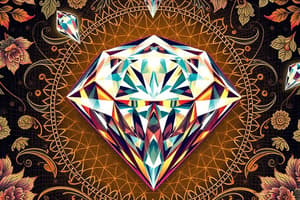Podcast
Questions and Answers
What are the two primary types of rocks where diamonds form?
What are the two primary types of rocks where diamonds form?
- Basalt and Granite
- Shale and Limestone
- Sandstone and Quartzite
- Peridotite and Eclogite (correct)
Which geological formations are known to transport diamonds to the surface?
Which geological formations are known to transport diamonds to the surface?
- Basalt and Rhyolite
- Kimberlite and Lamproite (correct)
- Gneiss and Diorite
- Granite and Schist
What is the most common cause of blue color in diamonds?
What is the most common cause of blue color in diamonds?
- High Temperature during Formation
- Presence of Nitrogen
- Absence of Oxygen
- Inclusion of Boron (correct)
Where do diamonds primarily form when carbon is available?
Where do diamonds primarily form when carbon is available?
Which type of diamond is known to be the toughest?
Which type of diamond is known to be the toughest?
What is the toughest form of diamond made up of many tiny diamond crystals?
What is the toughest form of diamond made up of many tiny diamond crystals?
What geological process delivers diamonds to the earth's surface?
What geological process delivers diamonds to the earth's surface?
Which of the following best describes the composition of diamond and graphite?
Which of the following best describes the composition of diamond and graphite?
What is the primary layer of the earth where most diamond deposits can be found?
What is the primary layer of the earth where most diamond deposits can be found?
What occurs during the process of subduction?
What occurs during the process of subduction?
What is a 'pipe' in geological terms?
What is a 'pipe' in geological terms?
Which part of the earth's structure is known to be the innermost layer?
Which part of the earth's structure is known to be the innermost layer?
What drives the movement of the earth's plates?
What drives the movement of the earth's plates?
The transition zone is ....?
The transition zone is ....?
A Diamond that formed at 410 km or deeper beneath the earth’s surface is ?
A Diamond that formed at 410 km or deeper beneath the earth’s surface is ?
A natural material composed of one or more kinds of minerals is a ?
A natural material composed of one or more kinds of minerals is a ?
The majority of mined diamonds are superdeep or ?
The majority of mined diamonds are superdeep or ?
Diamond formation requires extreme pressures and temperatures, and ?
Diamond formation requires extreme pressures and temperatures, and ?
Mantle keels under cratons are an environment for ?
Mantle keels under cratons are an environment for ?
Cratons are ?
Cratons are ?
The surface and outer most layer of the earth is ?
The surface and outer most layer of the earth is ?
Rare diamond that forms in the continental crust at or near the earth’s surface due to meteorite impact or tectonic plate collision is ?
Rare diamond that forms in the continental crust at or near the earth’s surface due to meteorite impact or tectonic plate collision is ?
A Carbonate is a class of chemical compounds that contains ...?
A Carbonate is a class of chemical compounds that contains ...?
A CLIPPER diamond is defined as ?
A CLIPPER diamond is defined as ?
The rate of temperature increase with depth in the earth is called ?
The rate of temperature increase with depth in the earth is called ?
A type of rock formed from a molten state.
A type of rock formed from a molten state.
The theory of the formation, structure, and movement of the earth’s landmasses is ?
The theory of the formation, structure, and movement of the earth’s landmasses is ?
A large, downward-protruding portion of the lithosphere under a craton is ?
A large, downward-protruding portion of the lithosphere under a craton is ?
The layer that contains the crust and the uppermost part of the mantle ....?
The layer that contains the crust and the uppermost part of the mantle ....?
Boron in blue diamonds originates from ...?
Boron in blue diamonds originates from ...?
Diamonds were delivered to the surface between ?
Diamonds were delivered to the surface between ?
Any molten rock within the earth is ?
Any molten rock within the earth is ?
The layer between the earth's crust and its core is ?
The layer between the earth's crust and its core is ?
A process in which chemical changes in minerals and rocks result from the introduction of material from external sources, often fluids or melts.
A process in which chemical changes in minerals and rocks result from the introduction of material from external sources, often fluids or melts.
A type of rock that has been altered by heat and pressure.
A type of rock that has been altered by heat and pressure.
A natural, inorganic substance with characteristic chemical composition and usually characteristic structure.
A natural, inorganic substance with characteristic chemical composition and usually characteristic structure.
• The earth’s basic structure consists of......
• The earth’s basic structure consists of......
What type of diamonds form deeper within the mantle opposed to mantle keels ?
What type of diamonds form deeper within the mantle opposed to mantle keels ?
Inclusions can indicate ....
Inclusions can indicate ....
What is an essential part of diamond formation?
What is an essential part of diamond formation?
Kimberlite tends to occur in the center of cratons, while lamproite occurs ....
Kimberlite tends to occur in the center of cratons, while lamproite occurs ....
The mantle can be divided into three broad layers....
The mantle can be divided into three broad layers....
Kimberlite and lamproite form .........
Kimberlite and lamproite form .........
CLIPPIR diamonds crystallized from ....
CLIPPIR diamonds crystallized from ....
Diamond-bearing kimberlite is much more common than diamond-bearing ...........
Diamond-bearing kimberlite is much more common than diamond-bearing ...........
Very few kimberlites or lamproites contain diamonds in ......?
Very few kimberlites or lamproites contain diamonds in ......?
Flashcards
Diamond Formation
Diamond Formation
Diamonds form under extreme pressure and temperature in the Earth's mantle, primarily from carbon.
Mantle Keels
Mantle Keels
Areas found below cratons in the mantle, a key location for diamond formation.
Superdeep Diamonds
Superdeep Diamonds
Diamonds that form deep in the Earth's mantle, far below mantle keels.
Lithospheric Diamonds
Lithospheric Diamonds
Signup and view all the flashcards
Kimberlite
Kimberlite
Signup and view all the flashcards
Lamproite
Lamproite
Signup and view all the flashcards
Diamond Inclusions
Diamond Inclusions
Signup and view all the flashcards
Carbonado
Carbonado
Signup and view all the flashcards
Blue Diamond Color
Blue Diamond Color
Signup and view all the flashcards
Carbonado
Carbonado
Signup and view all the flashcards
Carbonate
Carbonate
Signup and view all the flashcards
CLIPPIR Diamonds
CLIPPIR Diamonds
Signup and view all the flashcards
Core
Core
Signup and view all the flashcards
Cratons
Cratons
Signup and view all the flashcards
Crust
Crust
Signup and view all the flashcards
Crustal Diamond
Crustal Diamond
Signup and view all the flashcards
Eruption
Eruption
Signup and view all the flashcards
Geothermal Gradient
Geothermal Gradient
Signup and view all the flashcards
Igneous Rock
Igneous Rock
Signup and view all the flashcards
Lithosphere
Lithosphere
Signup and view all the flashcards
Magma
Magma
Signup and view all the flashcards
Mantle
Mantle
Signup and view all the flashcards
Mantle Keels
Mantle Keels
Signup and view all the flashcards
Metamorphic Rock
Metamorphic Rock
Signup and view all the flashcards
Metasomatism
Metasomatism
Signup and view all the flashcards
Mineral
Mineral
Signup and view all the flashcards
Pipe
Pipe
Signup and view all the flashcards
Plate Tectonics
Plate Tectonics
Signup and view all the flashcards
Rocks
Rocks
Signup and view all the flashcards
Subduction
Subduction
Signup and view all the flashcards
Superdeep Diamonds
Superdeep Diamonds
Signup and view all the flashcards
Transition Zone
Transition Zone
Signup and view all the flashcards
Study Notes
Diamond Formation
- Diamonds are composed of carbon.
- Earth's structure includes crust, mantle, and core.
- Mantle has upper, lower, and transition zones.
- Mantle convection moves Earth's plates.
- Subduction is crucial in diamond formation.
- Diamonds form in peridotite and eclogite rocks.
- High pressure, temperature, and carbon needed for formation.
- Mantle keels (under cratons) have diamond-forming conditions.
- Not all diamonds form in mantle keels; some are superdeep.
- Diamond formation occurs where carbon bonds with other carbon atoms without oxygen
- Inclusions can trace a diamond's origin within the Earth.
- Most mined diamonds are lithospheric or superdeep.
- Boron creates blue diamonds (originates from oceanic plates).
- Carbonado is a tough form of diamond.
Diamond Transport
- Diamonds reached Earth's surface between 2.5 billion and 20 million years ago.
- Kimberlite and lamproite carry diamonds to the surface.
- Kimberlite more common than lamproite.
- Kimberlite usually found in craton centers; lamproite at edges.
- Kimberlite and lamproite are pipe deposits.
- Few kimberlites/lamproites have economic diamond quantities.
Diamond Properties
- Carbonado is the strongest form of diamond.
- CLIPPIR diamonds formed from metallic melts (transition zone/lower mantle).
Studying That Suits You
Use AI to generate personalized quizzes and flashcards to suit your learning preferences.




